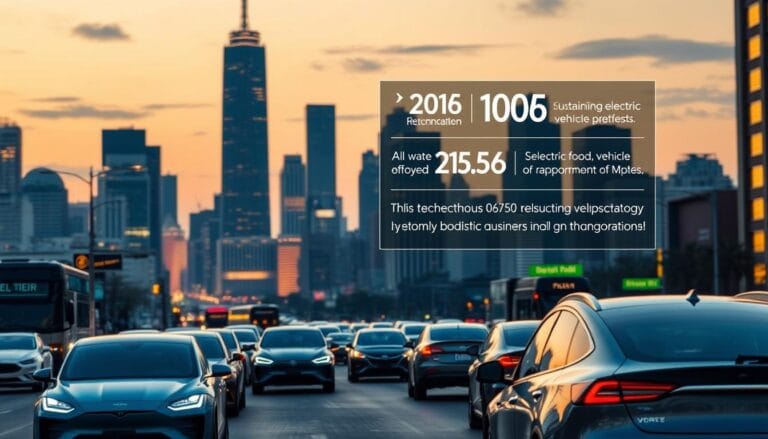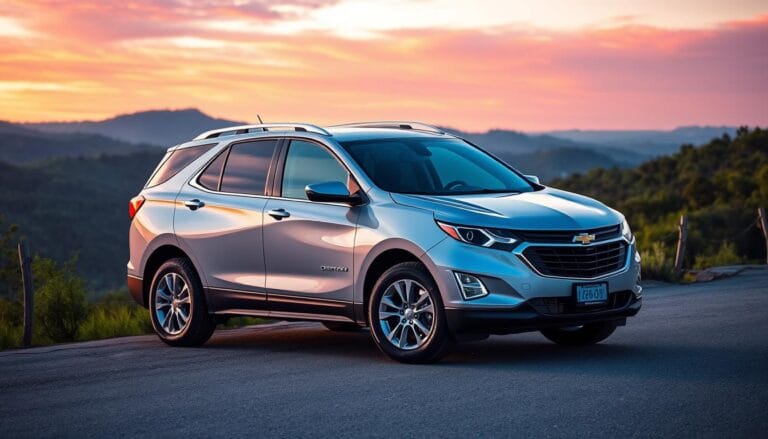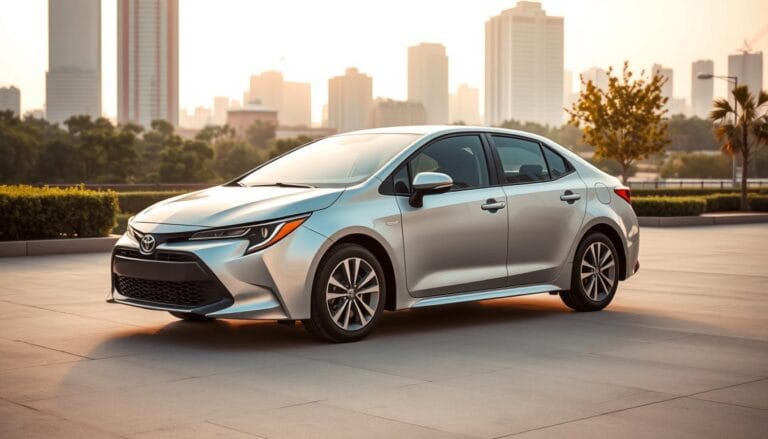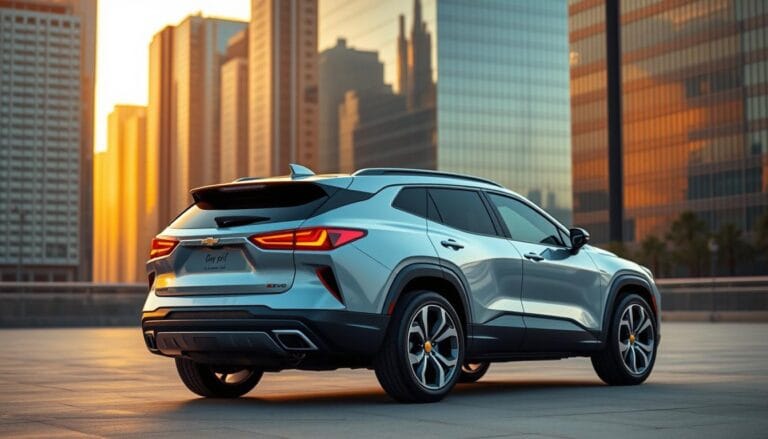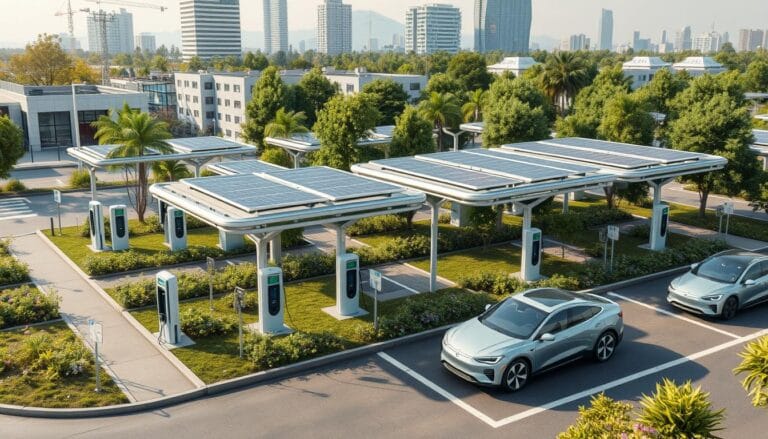EV Battery Innovations of 2025: Powering Longer Drives with New Tech
The electric vehicle revolution is about to shift into high gear. Imagine driving 500 miles on a single charge, with batteries that power up in just seconds. This isn’t a distant dream—it’s the reality of EV battery innovations coming in 2025.
Electric vehicle range has been a persistent concern for drivers. Now, breakthrough technologies are transforming how we think about electric mobility. From SVOLT’s cobalt-free batteries promising 500-mile ranges to StoreDot’s five-minute charging capabilities, the future of electric vehicles looks brighter than ever.
These EV battery innovations are more than technological marvels. They represent a fundamental shift in how you’ll experience transportation. Longer drives, faster charging, and increased reliability are no longer wishful thinking but imminent realities.
Table of Contents
Understanding EV Battery Innovations
The electric vehicle (EV) battery world is changing fast. By 2025, battery tech will be key in car innovation. The push for better battery energy and lower costs is leading to big leaps forward.
New tech is changing how we see electric vehicle power. Scientists and makers are working hard to make batteries more efficient and last longer. This could change how you drive.
What Drives Battery Technology Forward?
Several key factors are speeding up battery development:
- More people want cars that go further
- Green tech gets government support
- New discoveries in materials science
- Costs need to go down
Lithium-ion batteries are the top choice for EVs, making up about 80% of the market. The chance for new ideas is huge. Solid-state batteries could offer up to 500 Wh/kg, much more than today’s 150-250 Wh/kg.
Key Players in the EV Battery Revolution
The EV battery market is set to grow fast, at 20% each year. New companies are leading the way, creating tech that could change electric cars forever.
| Technology | Potential Impact | Estimated Market Growth |
|---|---|---|
| Silicon Anodes | 50% increased energy density | High |
| Solid-State Batteries | Improved safety and efficiency | Very High |
| Advanced Battery Management Systems | 30% extended battery lifespan | Moderate |
Your next electric car could have these new features. This makes EVs more useful, cheaper, and better for the planet than ever.
Major Trends in EV Battery Technology
The world of electric vehicle batteries is changing fast. New discoveries are making our cars more powerful. As more people choose electric cars, battery tech is leading the way.
In 2024, the electric car market saw big changes in battery tech. Demand for batteries hit 1 terawatt-hour. And, the world’s ability to make batteries reached 3 TWh. These steps are paving the way for better solid-state batteries and longer electric car drives.
Solid-State Batteries: Revolutionizing Electric Vehicle Performance
Solid-state batteries are changing the game for electric cars. They’re different from old lithium-ion batteries in key ways:
- Faster charging times
- More energy stored
- Better safety
- Longer battery life
“Solid-state batteries represent the next frontier in electric vehicle technology, promising to transform how we think about range and charging.” – EV Industry Expert
Recharging Revolution: Lithium-Ion Advancements
Lithium-ion batteries are getting better, too. They’re charging faster and using energy more efficiently. The market has seen big leaps, like:
- Battery pack prices dropping nearly 14%
- Lithium-iron phosphate (LFP) batteries now covering almost 50% of the global EV market
- LFP batteries becoming approximately 30% less expensive than traditional lithium nickel cobalt manganese oxide batteries
When you’re looking at electric cars, remember these tech upgrades. They mean longer drives and quicker charges. The future of EV batteries is all about making your drive better.
The Role of Tesla in EV Battery Advancements
Tesla is changing the game in electric vehicles. They’re leading the way in fast charging and longer driving ranges. Their new ideas are making cars better and more efficient.
In 2024, Tesla made huge strides in the electric car world. They hit a big milestone at their Fremont Factory, making 3 million EVs. Gigafactory Texas also started making 4680 battery cells at an incredible rate.
Tesla’s Supercharger Network Expansion in 2025
Tesla has big plans for their Supercharger network. They aim to:
- Grow their charging stations worldwide
- Make charging faster
- Work with other car brands
They want to make it easier to charge your car. This means you can drive longer without needing to stop for a charge.
How Tesla’s Innovations Affect Your Driving Experience
Tesla’s new battery tech changes how you drive. Here are some ways:
| Innovation | Impact |
|---|---|
| 4680 Battery Cells | More range and power |
| Structural Battery Pack | More efficient cars |
| LFP Battery Technology | Cheaper, greener options |
The global EV market is set to explode, growing to $4.3 trillion by 2033. Tesla is leading the charge in fast charging technology and electric vehicle range.
The Impact of KGM Musso EV Launch
The electric vehicle market is on the verge of a big change with the KGM Musso EV launch in 2025. This new electric pickup truck will introduce innovative battery management systems. These could change how you drive.
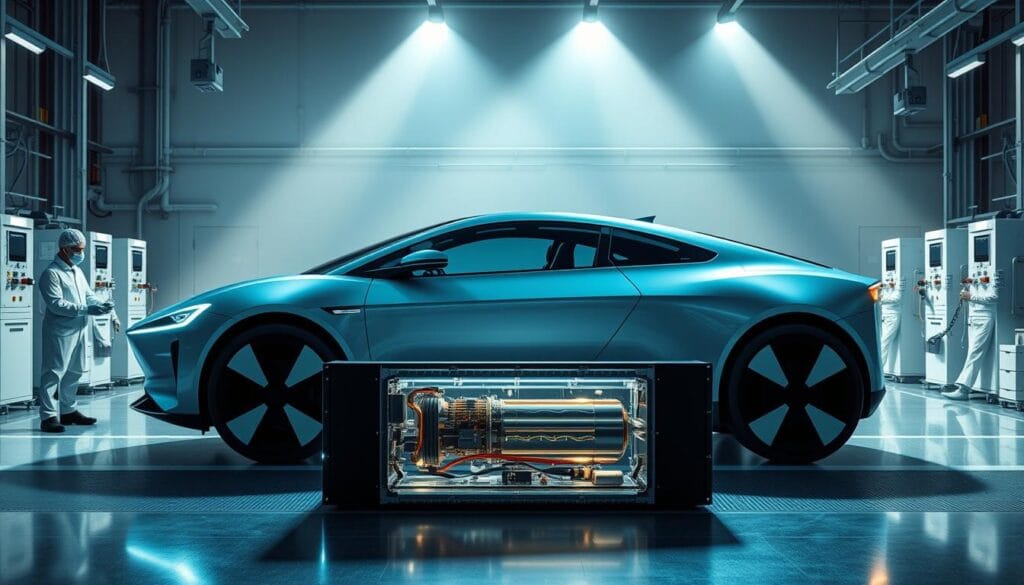
KG Mobility is aiming to make a mark in the electric vehicle market with the Musso EV. With sales expected to hit 164,000 vehicles in 2024, the company is making big moves.
Design Features Enhancing Battery Efficiency
The Musso EV has advanced design elements to boost battery efficiency. Key features include:
- Optimized aerodynamic profile to reduce energy consumption
- Advanced lightweight materials reducing overall vehicle weight
- Intelligent battery management systems for improved performance
Range Capabilities: What It Means for You
Your driving range is set to improve. The KGM Musso EV could last up to 200,000 miles without battery degradation. This means less worry about battery replacement and lower costs over time.
With plans to export 3,000 more vehicles in 2025, KG Mobility sees the Musso EV as a top choice. It’s for those looking for reliable and efficient electric transport.
Environmental Implications of New Battery Tech
Electric vehicle batteries are changing the car world, but they also raise big environmental questions. As more people choose electric cars, makers and scientists are working on new ways to make batteries better for the planet. They aim to cut down the harm caused by making and recycling batteries.
The issues with EV batteries are big. An electric car needs six times more minerals than a gas car. This high need puts a lot of pressure on the environment, mainly in areas where minerals are mined.
Sustainable Materials in Battery Production
New tech is coming to solve these problems. Scientists are looking into better materials for batteries that could change how they’re made:
- LFP (Lithium Iron Phosphate) batteries that don’t need cobalt
- New ways to mine minerals like “direct lithium extraction”
- Smaller batteries that need less minerals
Recycling Initiatives and Their Importance
Battery recycling is key to lessening harm to the environment. Efforts are underway to make a loop where minerals from old batteries can be used again. This could greatly lower costs and reduce the need for new minerals.
New ideas are popping up. For example, IBM Research found ways to make batteries from seawater. This could make making batteries greener and keep them working well.
By focusing on recycling and making batteries in a greener way, the car world is moving towards being kinder to our planet. It’s a big step towards making cars that are better for the environment.
Comparing Current Battery Types: Pros and Cons
Electric vehicle technology is moving fast, and knowing about battery innovations is key for EV owners. The world of electric vehicle power sources is changing quickly. Solid-state batteries are seen as a big step up from traditional lithium-ion batteries.
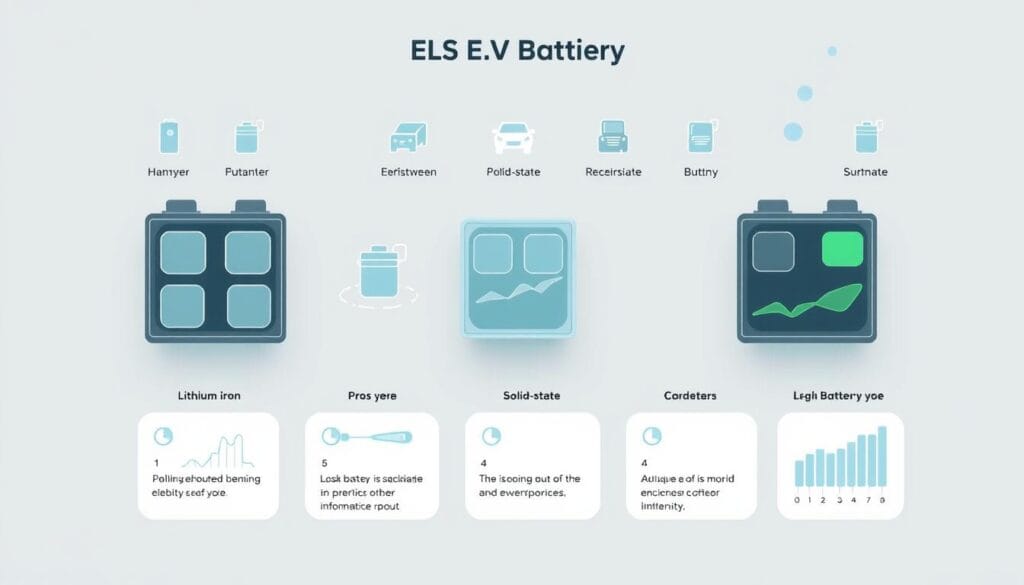
The electric vehicle market is set to hit over $1 trillion by 2029. This makes battery tech very important for car makers. Different battery types have their own good points and challenges that affect how you drive.
Lithium-Ion vs. Solid-State: A Detailed Comparison
Lithium-ion batteries are the top choice for EVs now. They work well but have some downsides. Here’s what they offer:
- High energy density for longer drives
- Typical lifespan of 8-15 years
- Most used battery type today
Solid-state batteries are the future of EV power. Companies like Solid Power Inc. are leading the way with sulfide-based all-solid-state cells. They promise big improvements:
- Even more energy density
- Quicker charging
- Less fire risk
The Future of Alternative Battery Technologies
“Battery technology is the key to unlocking the full electric vehicle’s power.” – EV Industry Expert
New options like lithium-metal and silicon anode batteries are breaking new ground. Silicon anode batteries could take an EV up to 547 miles. That’s 237 miles more than traditional graphite anodes.
Car makers plan to spend about $1.2 trillion by 2030 on EV and battery research. This means we’ll see huge leaps in solid-state batteries and other new power solutions.
Pricing Trends in EV Battery Innovations
The electric vehicle market is seeing big changes in battery prices. Making batteries cheaper is a big goal for makers, aiming to make electric cars more affordable. The global EV battery market is expected to grow from $91.93 billion in 2024 to $251.33 billion by 2035, with a growth rate of 9.6% each year.
Several factors are driving down battery prices. These include new technologies and changes in the market. Here are the main trends affecting electric vehicle range and cost:
- Battery prices are dropping faster than expected
- New technologies are making batteries more energy-dense
- Costs of battery metals are going down
Cost Reductions and Market Impact
The electric vehicle world is changing fast with new battery tech. About 60% of battery costs come from metals like lithium and cobalt. Experts say over 40% of battery price drops from 2023 to 2030 will be due to cheaper metals.
| Battery Type | Market Share | Projected Growth |
|---|---|---|
| Nickel-based Batteries | 60% | Continued Dominance |
| Lithium Ferrophosphate (LFP) | 35-40% | Increasing to 45% by 2025 |
| Solid-State Batteries | 5-10% | Emerging Technology |
Government Incentives for EV Battery Adoption
Government policies are helping EVs become more popular. The EU’s March 2023 law requires all new cars to have zero CO₂ emissions by 2035. This law is creating big opportunities in the market. It’s driving innovation and making electric cars more appealing to those looking for lower costs and improved electric vehicle range.
As battery tech keeps getting better, expect to see more affordable and efficient electric cars. These cars will have longer ranges and less environmental impact.
The Role of Partnerships in Evolving Battery Technology
The world of electric vehicle batteries is changing fast. This is thanks to partnerships between car makers and tech companies. These teams are working hard on solid-state batteries and fast charging. They aim to change the electric car market for the better.
The market for solid-state batteries is expected to grow a lot. It’s predicted to hit $257.2 billion by 2030. Big names are teaming up to solve big battery tech problems:
- Toyota is working with battery research firms
- BMW is investing $130 million in solid-state battery research
- Apple is teaming up with BYD to improve battery performance
Breakthrough Collaborations Driving Innovation
Some partnerships are really exciting. The partnership between Apple and BYD is one to watch. They’re working on new battery cells together. This shows how tech and cars can team up to make big changes.
| Automaker | Partnership Focus | Expected Breakthrough |
|---|---|---|
| Toyota | Solid-state battery research | Next-gen bZ4X EV lineup |
| BMW | Advanced battery technology | SSB integration by 2026 |
| Volkswagen | Flagship SSB models | Launch planned for 2025 |
How These Partnerships Benefit You as a Driver
These partnerships mean good things for electric car drivers. You’ll get cars that go further, charge faster, and cost less. The goal is to make batteries that last up to 1,200 kilometers and charge in just 10 minutes.
With so many big names working on new battery tech, electric cars are getting better fast. Your driving experience will soon be more efficient, green, and fun.
Future Charging Solutions for EVs
Electric vehicle charging technology is changing fast. New battery systems will make charging faster and easier. Soon, long trips in EVs will be more common than ever.
Ultra-fast chargers are coming. They will change how we charge electric vehicles. You’ll see:
- Recharging batteries to 80% in just 20 minutes
- Charging speeds reaching up to 350 kW
- More charging spots in cities and towns
Wireless Charging Technology on the Horizon
Soon, you might charge your car without plugging it in. Scientists are working on thin antennas that catch radio waves. These could charge your EV through the air, even while you’re driving.
Faster Charging Stations: A Breakthrough for Long Trips
The U.S. Department of Energy is boosting charging spots. They’re spending $68 million on new EV charging sites. By 2025, you’ll see:
- More charging networks everywhere
- Easier access to charging stations
- Shorter charging times
- Cheaper charging costs
These fast charging updates are big. They make EVs more practical for daily use. They’re a key step towards green transportation.
Consumer Perspectives on EV Battery Innovations
Drivers of electric vehicles are seeing big changes in battery tech. The world of electric cars has grown a lot. Now, electric cars can go much farther than they used to.
Today’s drivers are enjoying better battery systems. These changes are making driving electric cars even better. Let’s look at how these new features are changing what people expect:
Real-World Feedback from EV Owners
- Electric vehicle range has grown from 45 miles to 200-300 miles now
- Battery systems give more accurate guesses about how far you can go
- Charging times have gotten much shorter
- New battery tech makes cars more reliable
People are really happy with these updates. Drivers feel more confident about long trips. They know their cars can go far without needing to stop and charge as often.
Impact on Travel Experiences
Modern battery systems have changed how drivers plan and take trips. They can track energy use and find the best routes. This makes driving electric cars more efficient than ever.
The growth of battery tech has made electric cars a real option for millions.
As battery costs keep falling—down by about 97% in 30 years—more people can afford electric cars.
Looking Ahead: What is Next for EV Batteries?
The world of electric vehicle batteries is changing fast. Solid-state batteries are leading this change. By 2025, you’ll see big improvements that will make driving better. The U.S. is also growing its electric vehicle charging spots fast, aiming for over $24 billion by 2030.
Battery energy density is about to jump up a lot. Toyota and QuantumScape are working on new tech. This could make EVs go up to 745 miles and charge in just 10 minutes. General Motors has put $7 billion into solid-state battery research, showing a big change in electric vehicle power.
Future EVs might use new battery types like sodium-ion or lithium-sulfur. These could be cheaper and better for the planet. Big companies like CATL and BYD are putting a lot into these new techs. So, you can look forward to EVs that last longer and are kinder to the environment.
The next EVs will have different battery tech levels. High-end cars will use the latest solid-state batteries. But, more affordable cars will use LFP or sodium-ion. Researchers are even looking into getting lithium from seawater, which could change how batteries are made.


